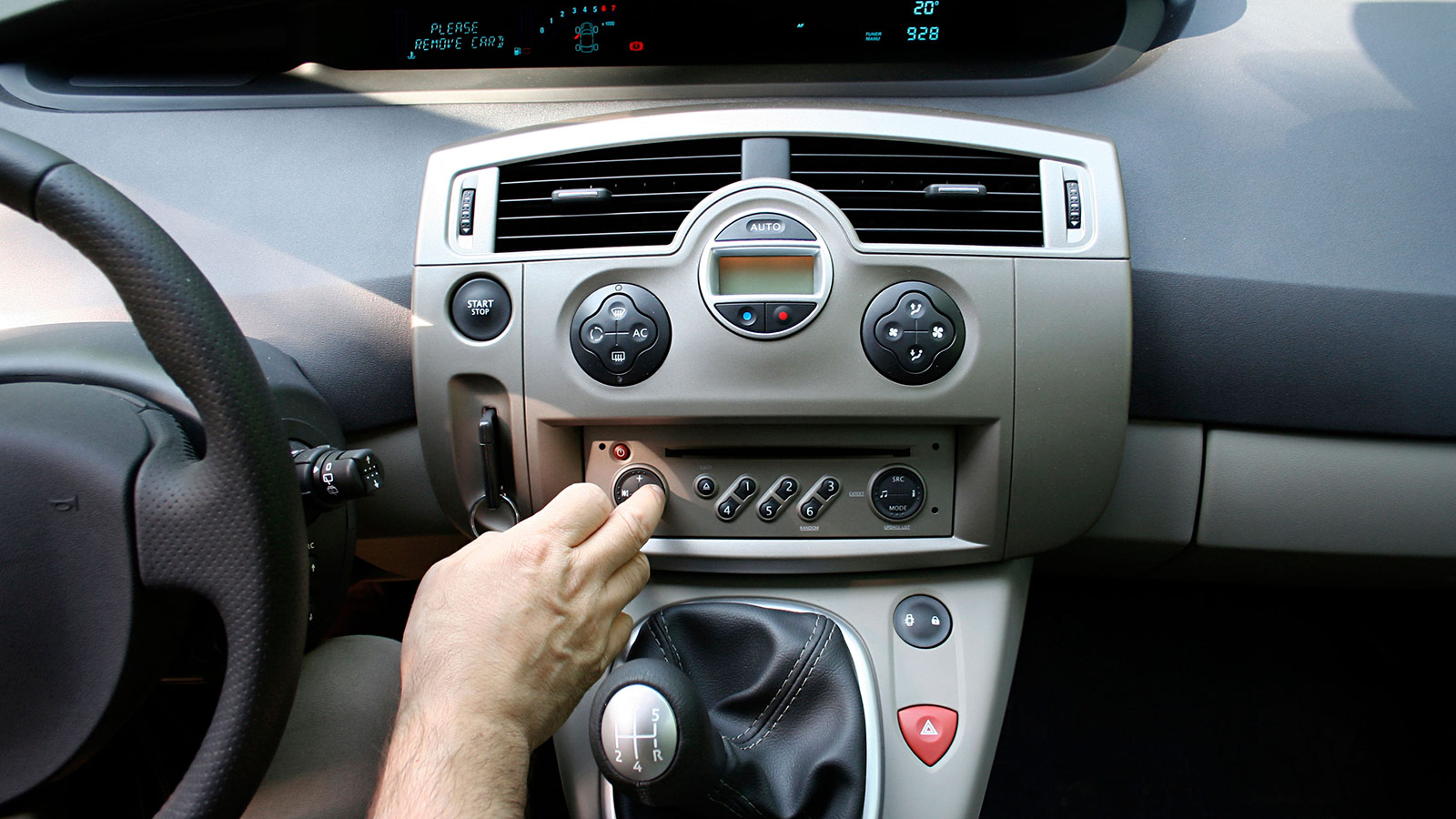Home>Devices & Equipment>Radio>When Was Radio Created


Radio
When Was Radio Created
Modified: January 22, 2024
Discover the fascinating history of radio, from its creation to its evolution as a powerful medium of communication, entertainment, and information.
(Many of the links in this article redirect to a specific reviewed product. Your purchase of these products through affiliate links helps to generate commission for AudioLover.com, at no extra cost. Learn more)
Table of Contents
- Introduction
- The Early Precursors to Radio
- The Invention of the Telegraph
- The Discovery of Electromagnetic Waves
- The Work of James Clerk Maxwell
- The Invention of the Telephone
- Heinrich Hertz and the Confirmation of Maxwell’s Theories
- The Milestones in the Development of Radio Technology
- The Role of Guglielmo Marconi
- The First Radio Transmission
- The Birth of Commercial Radio
- Conclusion
Introduction
Radio, a powerful medium that has captivated listeners around the world for over a century, holds a significant place in the history of communications. From its humble beginnings as a series of scientific discoveries to its establishment as a mainstream form of entertainment and information dissemination, radio has had a profound impact on society.
The invention of radio revolutionized the way we communicate and paved the way for the development of countless other technologies. It opened up a world of possibilities, allowing individuals to connect with others across great distances, share news and stories, and experience the joy of music and entertainment.
In this article, we will delve into the fascinating history of radio, exploring the early precursors to its creation, the key milestones in its technological development, and the individuals who played instrumental roles in its evolution.
By understanding the origins and advancements of radio, we gain a deeper appreciation for its immense influence on our lives and the world around us. So, let us embark on a journey through time and explore the captivating story of radio.
The Early Precursors to Radio
Before the invention of radio as we know it today, there were several key developments and discoveries in the field of telecommunication that laid the groundwork for its creation. Let’s explore some of these early precursors to radio.
One of the earliest precursors to radio was the invention of the telegraph. Developed in the early 19th century, the telegraph allowed for the transmission of coded messages over long distances using electrical signals. This breakthrough in communication technology paved the way for future advancements in wireless communication.
Another significant development was the discovery of electromagnetic waves. This groundbreaking discovery can be attributed to the work of several scientists, including Michael Faraday and James Clerk Maxwell. Their experiments and theories on electromagnetism laid the foundation for understanding the fundamental principles behind radio transmission.
In 1873, James Clerk Maxwell published his famous set of equations known as Maxwell’s equations. These equations not only mathematically described the behavior of electromagnetic waves but also predicted the existence of unseen waves that could travel through space. This was a crucial step towards the eventual invention of radio.
Building upon Maxwell’s theories, the invention of the telephone by Alexander Graham Bell in 1876 further pushed the boundaries of telecommunication. The telephone allowed for voice communication over long distances, demonstrating the potential for wireless transmission.
The breakthrough came in the late 19th century when German physicist Heinrich Hertz successfully demonstrated the existence of electromagnetic waves predicted by Maxwell’s equations. Hertz’s experiments, which involved generating and detecting radio waves, confirmed the theory and provided empirical evidence for the existence of these elusive waves.
These early precursors to radio laid the foundation for the development of wireless technology. They sparked curiosity and exploration in the scientific community, as researchers sought to harness the potential of these electromagnetic waves for practical applications in communication.
The Invention of the Telegraph
The invention of the telegraph was a groundbreaking development in the field of communication that set the stage for the eventual creation of radio. Developed in the early 19th century, the telegraph revolutionized long-distance communication by enabling the transmission of coded messages over great distances at unprecedented speeds.
The telegraph, invented by Samuel Morse and Alfred Vail in the early 1830s, utilized a system of electrical signals to convey messages. It consisted of a transmitter, called a telegraph key, and a receiver, known as a telegraph sounder. Operators would tap on the telegraph key to send electrical impulses, which would then be translated into written form at the receiving end.
One of the key innovations of the telegraph was the use of Morse code, a series of dots and dashes representing letters and numbers. This coded system allowed for efficient and reliable transmission of messages over long distances, as it only required the presence or absence of an electrical current.
The telegraph had a significant impact on various industries, particularly in the realm of commerce and transportation. Prior to its invention, information had to be physically transported by messengers or through slower means such as mail. The telegraph eliminated the need for these time-consuming and labor-intensive methods, allowing for near-instantaneous communication.
With the expansion of telegraph lines, information could be transmitted across vast distances in a matter of seconds. This development greatly facilitated the growth of businesses and industries, as it enabled faster coordination, increased efficiency, and improved decision-making.
The telegraph also played a pivotal role in connecting communities and bridging geographical divides. It brought people closer together, allowing them to exchange information and ideas across long distances. It facilitated the spread of news, enabling individuals to stay informed about local and international events in real-time.
Moreover, the telegraph laid the foundation for a global network of communication, connecting continents and revolutionizing long-distance communication. It spurred further advancements in telecommunication, leading to the development of more sophisticated forms of communication, such as the telephone and, eventually, radio.
Overall, the invention of the telegraph was a monumental achievement that revolutionized communication and paved the way for future advancements in the field. Its impact can still be felt today, as it laid the groundwork for the development of modern communication systems, including radio, which would transform the way we interact and connect with one another.
The Discovery of Electromagnetic Waves
The discovery of electromagnetic waves marks a significant milestone in the history of communication and is a crucial precursor to the invention of radio. The exploration of electricity and magnetism by various scientists in the 19th century paved the way for the understanding and harnessing of these invisible waves that would revolutionize the world of wireless communication.
One of the key pioneers in this field was Michael Faraday, an English scientist who conducted groundbreaking experiments on electricity and magnetism. Faraday’s work laid the foundation for the concept of electromagnetic fields, which would later become essential in understanding the propagation of electromagnetic waves.
James Clerk Maxwell, a Scottish physicist and mathematician, built upon Faraday’s work and formulated the theory of electromagnetism. In 1864, Maxwell published a set of equations known as Maxwell’s equations, which mathematically described the behavior of electromagnetic waves.
Maxwell’s equations integrated the laws of electricity and magnetism, predicting the existence of unseen waves that could travel through space. These waves were composed of electric and magnetic fields oscillating perpendicular to each other, propagating at the speed of light.
Maxwell’s groundbreaking theory sparked curiosity and fascination among scientists, as it implied the potential for wireless transmission of information over long distances. It provided the theoretical framework for understanding how electromagnetic waves could be harnessed for practical applications.
However, it was not until a few years later, in 1887, that German physicist Heinrich Hertz successfully demonstrated the existence of these electromagnetic waves. Hertz’s experiments involved generating and detecting these waves using specially designed apparatus.
Through his experiments, Hertz was able to generate electromagnetic waves and detect them with the use of a spark gap transmitter and a wire loop receiver. He observed that these waves possessed many properties similar to visible light waves, such as reflection, refraction, and interference.
Hertz’s experiments confirmed Maxwell’s theories, providing compelling evidence for the existence of electromagnetic waves and solidifying the foundation for the future development of wireless communication technologies.
The discovery of electromagnetic waves was a monumental achievement as it opened up new possibilities for transmitting information wirelessly, unbounded by physical connections. This breakthrough laid the groundwork for subsequent advancements in wireless communication, paving the way for the invention of radio and revolutionizing the way we communicate and connect with each other.
The Work of James Clerk Maxwell
James Clerk Maxwell, a Scottish physicist and mathematician, made significant contributions to the understanding of electromagnetism and laid the groundwork for the development of radio and other wireless communication technologies. His work revolutionized the field of physics and paved the way for the practical application of electromagnetic waves.
Maxwell’s most notable achievement was the formulation of the theory of electromagnetism. In 1864, he published a set of equations known as Maxwell’s equations, which mathematically described the behavior of electromagnetic fields and waves.
Maxwell’s equations brought together the laws of electricity and magnetism, providing a unified framework that explained their interrelationship. Through his equations, Maxwell predicted the existence of electromagnetic waves and their properties, including their propagation speed – the speed of light.
This groundbreaking theory challenged conventional understanding and sparked the imaginations of scientists and engineers, who began to envision the practical applications of electromagnetic waves for communication.
In addition to his equations, Maxwell made other important contributions to the field of electromagnetism. He developed the concept of electromagnetic fields, introducing the notion that electric and magnetic fields exist and interact with each other. This insight laid the foundation for the understanding of how electromagnetic waves are generated and propagate through space.
Maxwell’s work had a profound impact on the future development of wireless communication technologies. His theories provided the theoretical framework for understanding how information could be transmitted using electromagnetic waves, unbounded by physical connections.
Maxwell’s visionary work not only influenced the field of physics but also had practical implications. His theories formed the basis for the eventual invention of radio, as scientists and engineers built upon his ideas to develop the technology necessary for wireless communication.
He is widely regarded as one of the most influential physicists in history, and his discoveries continue to shape our understanding of the physical world. His pioneering work in electromagnetism laid the foundation for the modern age of wireless communication, enabling us to connect and communicate across vast distances in ways that were once unimaginable.
The Invention of the Telephone
The invention of the telephone by Alexander Graham Bell in 1876 was a momentous development in the history of communication. The telephone transformed the way people communicated, laying the groundwork for future advancements in wireless communication technologies, including radio.
Bell, a Scottish-born inventor, was inspired by his family’s work in speech and communication. His fascination with sound and speech led him to experiment with transmitting sound through electrical signals.
In his quest to transmit speech electrically, Bell developed the telephone – a device capable of transmitting and receiving sound over long distances. The telephone comprised a microphone to capture sound, an electrical current to encode the sound, and a receiver to convert the electrical signals back into audible sound.
On March 10, 1876, Bell famously made the first successful telephone call to his assistant, saying, “Mr. Watson, come here. I want to see you.” This groundbreaking achievement demonstrated the potential of the telephone as a means of instantaneous communication.
The invention of the telephone revolutionized communication by eliminating the need for physical presence or written messages to convey information. It allowed individuals to communicate in real-time, bridging distances and enabling conversations to take place across vast geographical areas.
The telephone rapidly gained popularity, leading to the establishment of telephone networks and services. People could connect with one another by simply picking up a receiver and dialing a number, ushering in a new era of instant and accessible communication.
While the telephone initially relied on physical wires to transmit electrical signals, its invention planted the seeds of wireless communication. Bell’s experiments and innovations paved the way for researchers and inventors to explore the potential of transmitting sound and information without the need for physical connections.
The invention of the telephone represents a significant stepping stone towards the eventual creation of radio and other wireless communication technologies. It sparked curiosity and imagination, encouraging further exploration and innovation in the field of wireless transmission.
Bell’s invention of the telephone revolutionized communication and set the stage for the future development of wireless technologies. It laid the foundation for the exponential growth of telecommunications and paved the way for the birth of radio as a powerful medium of communication and entertainment.
Heinrich Hertz and the Confirmation of Maxwell’s Theories
Heinrich Hertz, a German physicist, played a critical role in the confirmation of James Clerk Maxwell’s theories on electromagnetism. Through a series of groundbreaking experiments in the late 19th century, Hertz provided experimental evidence for the existence of electromagnetic waves, thus solidifying Maxwell’s theoretical work.
Hertz’s experiments involved the generation and detection of electromagnetic waves. He designed an apparatus known as a “Hertzian oscillator” to produce high-frequency electrical oscillations, which in turn generated electromagnetic waves. His setup included a spark gap transmitter that emitted bursts of electromagnetic energy when activated.
By placing a receiver, consisting of a metal loop with a small gap, in close proximity to the transmitter, Hertz was able to detect and measure the properties of the electromagnetic waves. He observed that these waves exhibited properties similar to visible light, such as reflection, refraction, and interference.
One of Hertz’s notable experiments involved the demonstration of the reflection and refraction of electromagnetic waves. He used metal plates and dielectric materials to manipulate the path of the waves and confirmed that they behaved in accordance with the laws of optics.
Hertz’s experiments were not only groundbreaking in themselves, but they also provided empirical evidence that supported Maxwell’s theories on electromagnetism. His work validated Maxwell’s equations and confirmed the existence of electromagnetic waves, which were predicted to travel at the speed of light.
The confirmation of Maxwell’s theories by Hertz was a significant milestone in the development of wireless communication. It provided scientific credibility to the concept of transmitting information through electromagnetic waves, paving the way for the practical application of this knowledge.
Hertz’s groundbreaking experiments had a profound impact on subsequent research and development in the field of wireless communication. His work inspired other scientists and inventors to further explore and harness the potential of electromagnetic waves for practical applications.
It is important to note that Hertz’s contributions extended beyond confirming Maxwell’s theories. His experiments laid the groundwork for subsequent advancements in wireless technologies, including the invention of radio. Hertz’s work formed the basis for the practical application of electromagnetic waves in communication and paved the way for the eventual development of wireless communication systems.
Heinrich Hertz’s experiments and confirmation of Maxwell’s theories solidified the understanding of electromagnetic waves and their properties. The significance of his work cannot be overstated, as it marked a crucial step towards the birth of radio and the subsequent revolution in wireless communication.
The Milestones in the Development of Radio Technology
The development of radio technology is a tale of remarkable innovation, with several key milestones that have shaped its evolution. From the conception of wireless communication to the establishment of commercial radio broadcasting, these milestones have paved the way for the modern world of radio as we know it today.
1. Wireless Telegraphy: The late 19th and early 20th centuries saw the emergence of wireless telegraphy, where information was transmitted via telegraph signals without the need for physical wires. Inventors such as Guglielmo Marconi and Nikola Tesla made breakthroughs in this field, paving the way for the future development of radio communication.
2. Reginald Fessenden’s Christmas Eve Broadcast: On December 24, 1906, Reginald Fessenden, a Canadian inventor, made history by conducting the first public radio broadcast. He transmitted a voice and music program from Brant Rock, Massachusetts, which was received up to 50 miles away. This significant event demonstrated the potential of radio as a means of mass communication.
3. Lee De Forest’s Audion Tube: In 1906, Lee De Forest invented the audion tube, a vacuum tube that amplified weak radio signals. This breakthrough in amplification technology greatly improved the range and quality of radio transmission and reception. The audion tube paved the way for the development of more sophisticated radio systems.
4. The Formation of Broadcast Networks: In the 1920s, radio broadcasting began to gain popularity, leading to the formation of radio networks. Broadcasting companies like the National Broadcasting Company (NBC) and the Columbia Broadcasting System (CBS) allowed for the widespread dissemination of news, entertainment, and educational content.
5. Frequency Modulation (FM) Radio: In the 1930s, Edwin Armstrong invented frequency modulation (FM) radio, which improved the quality and clarity of radio broadcasts. FM radio offered superior sound reproduction and resistance to interference, enhancing the overall listening experience for audiences.
6. The Emergence of FM Stereo: In the 1960s, FM stereo broadcasting became widely adopted, allowing listeners to experience high-quality, stereo sound. This milestone revolutionized the music industry, as it provided a new platform for the transmission of music in stunning stereo format.
7. Satellite Radio: In the 1990s, satellite radio services like Sirius XM Radio emerged, offering a wide range of commercial-free music, sports, news, and entertainment programming. Satellite radio provided listeners with an unparalleled selection of content, available nationwide, and free from traditional terrestrial radio constraints.
8. Internet Radio and Podcasting: With the rise of the internet, the concept of radio expanded further. Internet radio and podcasting platforms allowed for the creation and distribution of custom-tailored, on-demand audio content, enabling listeners to explore a vast array of specialized programming from around the world.
These milestones in the development of radio technology have revolutionized the way we receive and engage with audio content. From the early days of wireless telegraphy to the advent of internet radio, each milestone has contributed to the rich history and pervasive influence of radio in our society.
The Role of Guglielmo Marconi
Guglielmo Marconi, an Italian inventor and electrical engineer, played a pivotal role in the development and popularization of radio technology. His groundbreaking work and entrepreneurial spirit propelled radio from an experimental concept to a practical means of communication.
Marconi’s interest in wireless communication began in his teenage years, when he started experimenting with telegraphy. Building upon the works of previous inventors, he focused on extending the range of wireless transmission.
In 1895, Marconi successfully transmitted wireless signals over a distance of two kilometers, proving the potential of his wireless telegraphy system. This accomplishment marked the beginning of Marconi’s journey towards the development of practical radio communication.
Marconi continued to refine his wireless telegraphy system, increasing its range and commercial viability. In 1899, he successfully transmitted signals across the English Channel, a distance of approximately 32 kilometers. This achievement solidified Marconi’s reputation as a pioneer in wireless communication and prompted further advancements in the field.
One of Marconi’s most remarkable feats came in 1901 when he achieved the first transatlantic radio transmission. He sent a wireless signal from Poldhu in Cornwall, England, to St. John’s, Newfoundland, a distance of over 3,500 kilometers. This historic moment marked a significant leap forward in long-distance communication and firmly established Marconi as a leading figure in wireless transmission technology.
Marconi’s contributions to radio technology extended beyond his technical achievements. He was also a shrewd entrepreneur and businessman, establishing wireless telegraph companies and commercializing his inventions. His company, Marconi’s Wireless Telegraph Company, played a key role in the growth and development of radio technology internationally.
Furthermore, Marconi’s work laid the foundation for the establishment of international regulations and protocols for wireless communication. His demonstrations and experiments not only showcased the capabilities of radio but also highlighted the need for standardized practices and guidelines to govern this emerging field.
Marconi’s work and innovations earned him numerous accolades and honors, including the Nobel Prize in Physics in 1909, which he shared with German physicist Karl Ferdinand Braun, for his contributions to wireless telegraphy.
Guglielmo Marconi’s contributions to radio technology were immeasurable. His vision, ingenuity, and determination pushed the boundaries of communication, proving that information could be transmitted wirelessly over vast distances. Marconi’s work paved the way for the development and widespread adoption of radio as a vital medium of communication, shaping the modern world of wireless technology we know today.
The First Radio Transmission
The first successful radio transmission is attributed to Guglielmo Marconi, an Italian inventor and engineer, who achieved a groundbreaking milestone in the field of wireless communication. On December 12, 1901, Marconi successfully sent a radio signal across the Atlantic Ocean, marking a historic moment in the development of radio technology.
Marconi conducted this historic experiment in Newfoundland, Canada, at a location now known as Signal Hill. At the receiving end, he set up a wire antenna connected to a receiver equipped with a rudimentary detector known as a coherer.
In Cornwall, England, Marconi used a powerful transmitting station and an antenna consisting of a system of tall masts and a spark gap transmitter. This setup generated electromagnetic waves that were sent into space and crossed the vast expanse of the Atlantic.
The radio signal traveled approximately 3,500 kilometers (2,200 miles) across the Atlantic Ocean and was successfully received by a similar receiving apparatus in St. John’s, Newfoundland. Marconi had achieved the first transatlantic radio transmission, proving that wireless communication was indeed possible over long distances.
During this experimental transmission, the message sent by Marconi consisted of Morse code signals, spelling out the letter “S” in three short dots. This simple but significant transmission demonstrated the practicality of wireless communication for long-distance purposes.
Marconi’s successful transatlantic radio transmission was a turning point in the development of radio technology. It showcased the potential of radio to revolutionize global communication, making it possible to transmit messages and information across vast distances without the need for physical connections.
This achievement by Marconi generated immense excitement and set off a wave of enthusiasm for the possibilities of wireless communication. It opened up new horizons for the exchange of information, connected people across continents, and played a pivotal role in shaping the future of communication technology worldwide.
Marconi’s groundbreaking transatlantic radio transmission not only solidified his status as a pioneering figure in the field but also established radio as a practical means of communication. His demonstration inspired further advancements in wireless communication technologies, leading to the rapid expansion and development of radio as a vital medium of communication, entertainment, and information dissemination.
The Birth of Commercial Radio
The birth of commercial radio marked a significant turning point in the history of broadcasting, as it brought radio from experimental transmissions to a mass medium of communication and entertainment. The early 20th century witnessed the emergence of commercial radio stations and the rapid growth of radio as a viable industry.
One of the key figures in the development of commercial radio was Frank Conrad, an engineer working for Westinghouse Electric Corporation in Pittsburgh, Pennsylvania. In 1919, Conrad set up a small transmitter in his garage and began broadcasting music and news to his fellow radio enthusiasts in the local community.
Conrad’s broadcasts gained popularity, attracting an increasing number of listeners who eagerly tuned in to his station, known as KDKA. Sensing the potential for commercial success, Westinghouse transformed KDKA into the first commercially licensed radio station in the United States, officially launching on November 2, 1920.
The success of KDKA paved the way for the establishment of numerous other commercial radio stations across the country. These stations began offering a variety of programming, including news, music, sports, and entertainment, tailored to the interests and preferences of their specific audiences.
Radio stations began to generate revenue through advertising, as businesses recognized the power of radio as a promotional platform to reach a vast audience. Advertisements became an integral part of radio broadcasts, providing commercial opportunities for businesses and sustaining the financial viability of radio stations.
With the growth of commercial radio, the demand for radio receivers soared. People across the country purchased radios for their homes, eagerly tuning in to their favorite stations for news updates, music programs, and engaging content. This widespread adoption of radio as a household appliance accelerated the popularity and influence of radio as a mass medium.
The 1920s, often referred to as the “Golden Age of Radio,” witnessed further advancements in technology and programming. Radio companies experimented with new formats, such as serial dramas, comedy shows, and variety programs. The radio industry thrived, capturing the imagination of the public and transforming the way people consumed entertainment and information.
The birth of commercial radio revolutionized the media landscape, reshaping the concept of mass communication. Radio became a powerful platform for entertainment, news dissemination, and advertising, reaching a broad and diverse audience. It provided a common thread that connected communities and brought people together through shared experiences.
Commercial radio also played a significant role in the shaping of popular culture. It introduced listeners to new music genres, allowed for live broadcasts of sports events and political speeches, and fostered a sense of togetherness and shared experiences across regions.
Today, the legacy of commercial radio continues, even in the digital era. While technology may have changed, radio remains a critical medium, keeping listeners informed, entertained, and connected.
The birth of commercial radio laid the foundation for the dynamic and ever-evolving radio industry we know today, and its impact on popular culture and media cannot be overstated.
Conclusion
The evolution of radio technology has transformed the world of communication, connecting people across vast distances and shaping our modern society. From its early precursors to the birth of commercial radio, each milestone played a crucial role in the development of this powerful medium.
The journey began with the invention of the telegraph, enabling the transmission of coded messages over long distances. The discovery of electromagnetic waves by scientists like Faraday and Maxwell paved the way for the understanding of wireless transmission and the formulation of the theory of electromagnetism.
Visionaries such as Guglielmo Marconi and Heinrich Hertz took these theories and turned them into practical applications, proving the existence and possibilities of wireless communication. Marconi’s first transatlantic radio transmission and his subsequent work in commercializing radio opened the doors to a new era of mass communication.
The birth of commercial radio brought about the establishment of radio stations, the growth of advertising as a revenue source, and the widespread adoption of radio receivers in households worldwide. Radio became a medium through which people connected, entertained themselves, and stayed informed about local and global events.
The development of radio technology continued, with advancements in frequency modulation, the emergence of FM stereo and satellite radio, and the rise of internet radio and podcasting. Each innovation expanded the possibilities and reach of radio, enhancing the listener’s experience and offering a diverse range of programming choices.
Radio, in its many forms, remains a powerful force in the media landscape, adapting to the changing technological landscape while maintaining its relevance and influence. It continues to bridge gaps and foster a sense of community, providing a platform for artists, news broadcasters, and content creators to share their stories and connect with audiences.
In conclusion, the journey of radio from its early beginnings to the modern era is a testament to human ingenuity and the power of innovation. It has shaped the way we communicate, entertain, and receive information. Radio has become an integral part of our lives, and its impact will continue to resonate for years to come.











